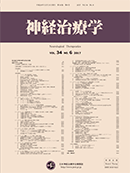34 巻, 1 号
選択された号の論文の17件中1~17を表示しています
- |<
- <
- 1
- >
- >|
-
2017 年 34 巻 1 号 p. 1
発行日: 2017年
公開日: 2017/05/31
PDF形式でダウンロード (213K)
Editorial(論説)
-
2017 年 34 巻 1 号 p. 3-7
発行日: 2017年
公開日: 2017/05/31
PDF形式でダウンロード (442K)
特集 脳血管病変と脳疾患
-
2017 年 34 巻 1 号 p. 8
発行日: 2017年
公開日: 2017/05/31
PDF形式でダウンロード (219K) -
2017 年 34 巻 1 号 p. 9-12
発行日: 2017年
公開日: 2017/05/31
PDF形式でダウンロード (947K) -
2017 年 34 巻 1 号 p. 13-17
発行日: 2017年
公開日: 2017/05/31
PDF形式でダウンロード (1138K) -
2017 年 34 巻 1 号 p. 18-23
発行日: 2017年
公開日: 2017/05/31
PDF形式でダウンロード (981K) -
2017 年 34 巻 1 号 p. 24-30
発行日: 2017年
公開日: 2017/05/31
PDF形式でダウンロード (1475K) -
2017 年 34 巻 1 号 p. 31-36
発行日: 2017年
公開日: 2017/05/31
PDF形式でダウンロード (2990K)
原著
-
2017 年 34 巻 1 号 p. 37-42
発行日: 2017年
公開日: 2017/05/31
PDF形式でダウンロード (809K) -
2017 年 34 巻 1 号 p. 43-46
発行日: 2017年
公開日: 2017/05/31
PDF形式でダウンロード (946K) -
2017 年 34 巻 1 号 p. 47-50
発行日: 2017年
公開日: 2017/05/31
PDF形式でダウンロード (1621K) -
2017 年 34 巻 1 号 p. 51-55
発行日: 2017年
公開日: 2017/05/31
PDF形式でダウンロード (838K)
神経治療最前線 海外学会参加報告
-
2017 年 34 巻 1 号 p. 56-57
発行日: 2017年
公開日: 2017/05/31
PDF形式でダウンロード (1286K)
-
2017 年 34 巻 1 号 p. 58-61
発行日: 2017年
公開日: 2017/05/31
PDF形式でダウンロード (364K) -
2017 年 34 巻 1 号 p. 63
発行日: 2017年
公開日: 2017/05/31
PDF形式でダウンロード (205K) -
2017 年 34 巻 1 号 p. 64
発行日: 2017年
公開日: 2017/05/31
PDF形式でダウンロード (206K) -
2017 年 34 巻 1 号 p. I1
発行日: 2017年
公開日: 2017/05/31
PDF形式でダウンロード (120K)
- |<
- <
- 1
- >
- >|
